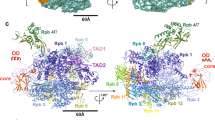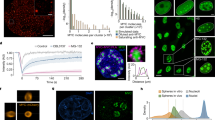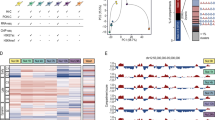Abstract
The p53 tumour suppressor functions as a sensor of genotoxic stress and, once activated, induces cell growth arrest or apoptosis. The precise intranuclear localization of latent p53 protein in non-stressed cells is unknown. Such information is essential in order to understand how relatively few molecules of p53 can detect and respond to DNA damage. Here we present the first detailed supramolecular localization of p53 in the nuclei of cells under normal conditions of growth. We show that soluble, non-bound p53 is released by permeabilization, leaving structurally bound p53 in both the nucleus and nucleolus. In situ biochemical studies reveal (i) that nuclear-bound p53 is tethered by RNA (directly or indirectly) and (ii) that a sub-population of nuclear-bound p53 co-localizes with sites of RNA synthesis. Transcriptional co-localization appeared to be independent of p53 conformation but dependent upon its quaternary structure. In the nucleolus p53 was observed at sites of rRNA synthesis and also adjacent to such sites. In contrast, nucleolar hdm-2 (shown by others to complex p53 and 5S RNA) was excluded from sites of rRNA synthesis. Our discovery that p53 is physically linked with sites of transcription may explain how relatively few p53 protein molecules can monitor genetic stress and respond preferentially to damage of actively transcribed genes.
This is a preview of subscription content, access via your institution
Access options
Subscribe to this journal
Receive 50 print issues and online access
$259.00 per year
only $5.18 per issue
Buy this article
- Purchase on Springer Link
- Instant access to full article PDF
Prices may be subject to local taxes which are calculated during checkout









Similar content being viewed by others
References
Aden DP, Fogel A, Plotkin S, Damjanov I and Knowles BB . 1979 Nature 282: 615–616.
Andera L and Wasylyk B . 1997 Mol Med 3: 852–863.
Barbarese E, Koppel DE, Deutscher MP, Smith CL, Ainger K, Morgan F and Carson JH . 1995 J Cell Sci 108: 2781–2790.
Bonsing BA, Corver WE, Gorsira MC, van Vliet M, Oud PS, Cornelisse CJ and Fleuren GJ . 1997 Cytometry 28: 11–24.
Budde A and Grummt I . 1999 Oncogene 19: 1119–1124.
Chen J, Marechal V and Levine AJ . 1993 Mol Cell Biol 13: 4107–4114.
Conchello JA, Kim JJ and Hansen EW . 1994 Appl Optics 33: 3740–3750.
Fay FS, Taneja KL, Shenoy S, Lifshitz L and Singer RH . 1997 Exp Cell Res 231: 27–37.
Fontoura BM, Sorokina EA, David E and Carroll RB . 1992 Mol Cell Biol 12: 5145–5151.
Frisken Gibson S and Lanni F . 1991 J Opt Soc Am A 8: 1601–1613.
Gobert C, Bracco L, Rossi F, Olivier M, Tazi J, Lavelle F, Larsen AK and Riou JF . 1996 Biochemistry 35: 5778–5786.
Gonzalez RC and Woods RE . 1993 Digital Image Processing 3rd edn Addison-Wesley Publishing Co Massachusetts 583–586.
Grande MA, van der Kraan I, de Jong L and van Driel R . 1997 J Cell Sci 110: 1781–1791.
He D, Nickerson JA and Penman S . 1990 J Cell Biol 110: 569–580.
Huang LC, Clarkin KC and Wahl GM . 1996 Proc Natl Acad Sci USA 93: 4827–4832.
Katsumoto T, Higaki K, Ohno K and Onodera K . 1995 Biol Cell 84: 167–173.
Kern SE, Kinzler KW, Bruskin A, Jarosz D, Friedman P, Prives C and Vogelstein B . 1991 Science 252: 1708–1711.
Knowles BB, Howe CC and Aden DP . 1980 Science 209: 497–499.
Ko LJ and Prives C . 1996 Genes Dev 10: 1054–1072.
Lane DP, Stephen CW, Midgley CA, Sparks A, Hupp TR, Daniels DA, Greaves R, Reid A, Vojtesek B and Picksley SM . 1996 Oncogene 12: 2461–2466.
Levine AJ . 1997 Cell 88: 323–331.
Ljungman M and Zhang F . 1996 Oncogene 13: 823–831.
Ljungman M, Zhang F, Chen F, Rainbow AJ and McKay BC . 1999 Oncogene 18: 583–592.
Manders EM, Verbeek FJ and Aten JA . 1993 J Microsc 169: 375–382.
Marechal V, Elenbaas B, Piette J, Nicolas JC and Levine AJ . 1994 Mol Cell Biol 14: 7414–7420.
Michael WM and Dreyfuss G . 1996 J Biol Chem 271: 11571–11574.
Milner J, Chan YS, Medcalf EA, Wang Y and Eckhart W . 1993 Oncogene 8: 2001–2008.
Mosner J, Mummenbrauer T, Bauer C, Sczackiel G, Grosse F and Deppert W . 1995 EMBO J 14: 4442–4449.
Müller M, Strand S, Hug H, Heinemann EM, Walczak H, Hofmann WJ, Stremmel W, Krammer PH and Galle PR . 1997 J Clin Invest 99: 403–413.
Pederson T . 1998 J Mol Biol 277: 147–159.
Pombo A and Cook PR . 1996 Exp Cell Res 229: 201–203.
Pritchard DM, Watson AJ, Potten CS, Jackman AL and Hickman JA . 1997 Proc Natl Acad Sci USA 94: 1795–1799.
Scheer U and Hock R . 1999 Curr Opin Cell Biol 11: 385–390.
Shaw PJ and Jordan EG . 1995 Ann Rev Cell Dev Biol 11: 93–121.
Stenoien D, Sharp D, Smith CL and Mancini MA . 1998 J Cell Biochem 70: 213–221.
Taneja KL, Lifshitz L, Fay FS and Singer RH . 1992 J Cell Biol 119: 1245–1260.
te Poele RH, Okorokov AL and Joel SP . 1999 Oncogene in press
van Gool AJ, van der Horst GT, Citterio E and Hoeijmakers JH . 1997 EMBO J 16: 4155–4162.
Wansink DG, Schul W, van der Kraan I, van Steensel B, van Driel R and de Jong L . 1993 J Cell Biol 122: 283–293.
Weber J, Jelinek W and Darnell JE . 1977 Cell 10: 611–616.
Weinstein JN, Ayers TG, O’Connor PM, Friend SH, Fornace AJ, Kohn KW, Fojo T, Bates SE, Rubinstein LV, Anderson NL, Buolamwini JK, van Osdol WW, Monks AP, Scudiero DA, Sausville EA, Zaharevitz DW, Bunow B, Viswanadhan VN, Johnson GS, Wittes RE and Paull KD . 1997 Science 275: 343–349.
Yamaizumi M and Sugano T . 1994 Oncogene 9: 2775–2784.
Zerrahn J, Deppert W, Weidemann D, Patschinsky T, Richards F and Milner J . 1992 Oncogene 7: 1371–1381.
Acknowledgements
We wish to thank Andrei Okorokov for many in-depth discussions. This work was funded by Yorkshire Cancer Research.
Author information
Authors and Affiliations
Rights and permissions
About this article
Cite this article
Rubbi, C., Milner, J. Non-activated p53 co-localizes with sites of transcription within both the nucleoplasm and the nucleolus. Oncogene 19, 85–96 (2000). https://doi.org/10.1038/sj.onc.1203378
Received:
Accepted:
Published:
Issue Date:
DOI: https://doi.org/10.1038/sj.onc.1203378
Keywords
This article is cited by
-
Colocalization by cross-correlation, a new method of colocalization suited for super-resolution microscopy
BMC Bioinformatics (2024)
-
Three major nucleolar proteins migrate from nucleolus to nucleoplasm and cytoplasm in root tip cells of Vicia faba L. exposed to aluminum
Environmental Science and Pollution Research (2014)
-
Nucleolar control of p53: a cellular Achilles’ heel and a target for cancer therapy
Cellular and Molecular Life Sciences (2014)
-
Aggresome-forming TTRAP mediates pro-apoptotic properties of Parkinson's disease-associated DJ-1 missense mutations
Cell Death & Differentiation (2009)
-
Energy-dependent nucleolar localization of p53 in vitro requires two discrete regions within the p53 carboxyl terminus
Oncogene (2007)



